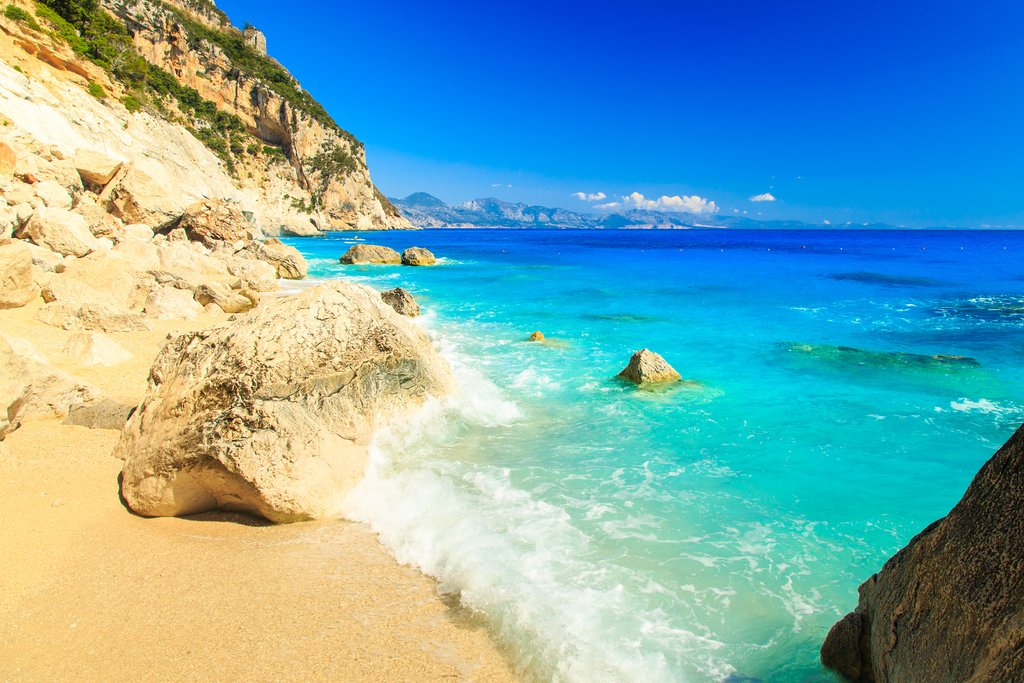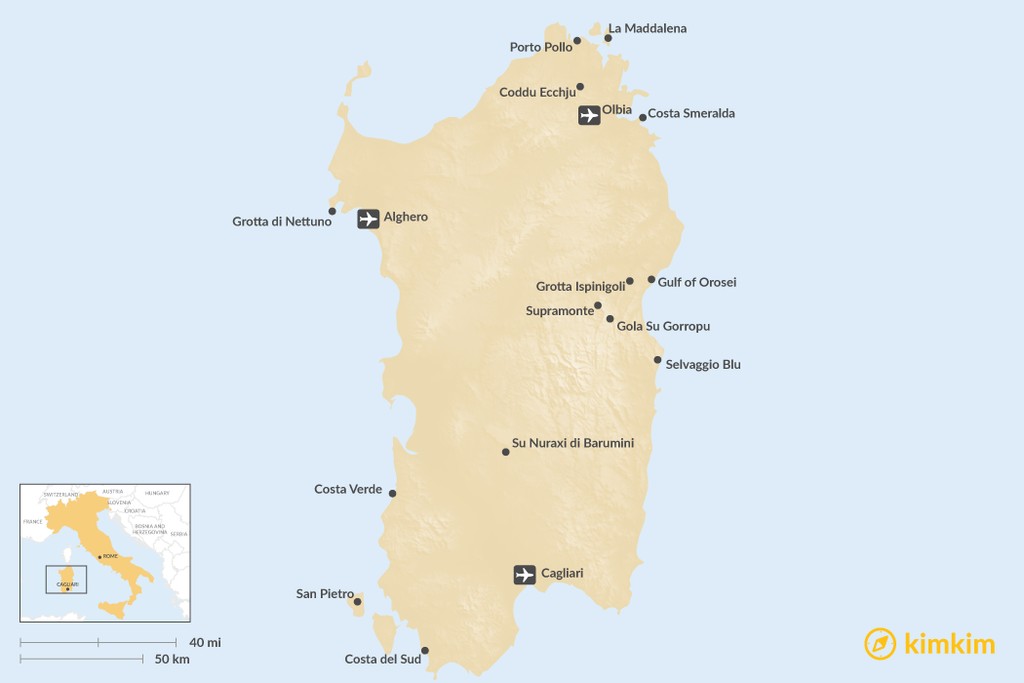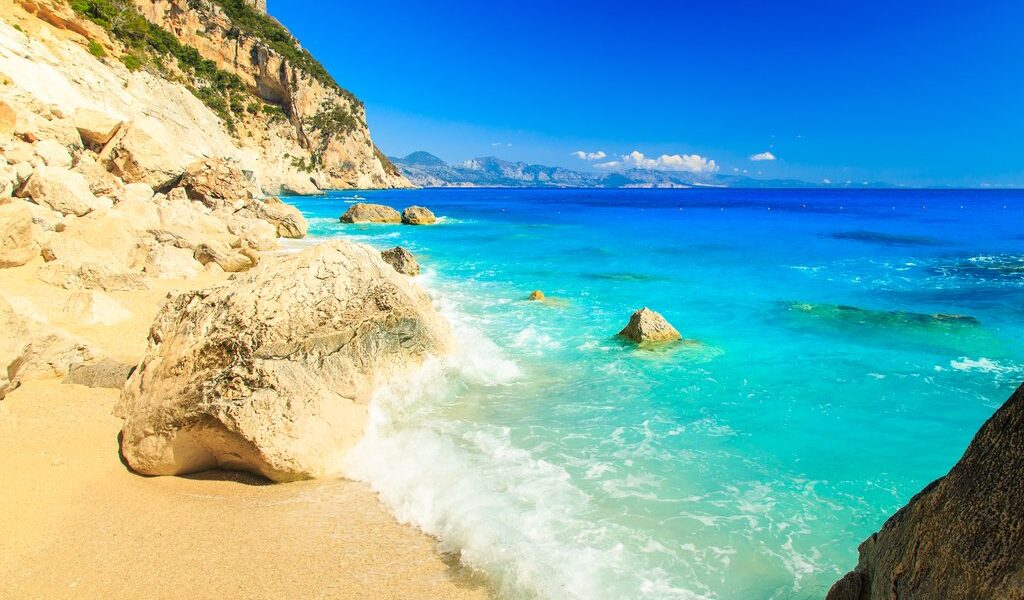
If you’re coming to Sardinia for the flour-white beaches sloping into glass-clear turquoise seas, you’ll find them in abundance. But this island is more than a one-hit wonder, with a forest-cloaked mountainous interior to explore, uplifting clifftop trails to hike and Bronze Age remains to uncover. Historically, culturally and gastronomically, this wild and ravishing Italian isle is a one-off.
## Unveiling Sardinia: A Mediterranean Jewel
Sardinia, a land of breathtaking beauty and ancient mysteries, beckons travelers with its unique blend of natural wonders, cultural richness, and culinary delights. As the second-largest island in the Mediterranean Sea, surpassed only by Sicily, Sardinia lies nestled off the western coast of Italy, a stone’s throw south of the captivating French island of Corsica. This strategic location has blessed Sardinia with a diverse history and a distinct identity, setting it apart from its mainland neighbor.
Prepare to be mesmerized by Sardinia’s coastline, a sprawling expanse of 1178 miles that cradles some of Europe’s most stunning beaches. Picture yourself sinking your toes into the powdery sand, gazing out at the shimmering turquoise waters, and breathing in the invigorating sea air. But Sardinia is more than just sun and sand. Its rugged interior boasts majestic mountains that challenge even the most seasoned climbers and trekkers, promising exhilarating adventures and panoramic views.
Delve into Sardinia’s intriguing past as you explore its 7000 *nuraghi*, enigmatic Bronze Age towers and tombs that stand as silent witnesses to a bygone era. These ancient structures offer a fascinating glimpse into prehistory, sparking curiosity and igniting the imagination. Exploring these sites is a journey back in time, connecting you to the island’s earliest inhabitants and their remarkable legacy.
While the Sardinians, or Sards, may initially appear similar to their Italian counterparts, a closer look reveals a distinct cultural tapestry. Beyond the familiar sounds of Italian, you’ll hear the melodious strains of Sardinian, a language that reflects the island’s unique heritage. The cuisine, too, offers subtle yet significant differences, with locals adding their own creative twists to classic dishes like bread, pasta, and *dolci* (sweets). Traditional celebrations and *festes* (festivals) further showcase Sardinia’s vibrant cultural identity, providing unforgettable experiences for visitors.
## Crafting Your Sardinian Adventure
Sardinia’s size is deceptive; it’s an island that demands time and attention. Many travelers underestimate the distances involved, attempting to cram too much into a single week. To truly appreciate the island’s diverse offerings, plan for a journey of two to three weeks. Alternatively, focus your exploration on a specific region, coastline, or activity to create a more immersive experience. Perhaps consider drawing inspiration from curated itineraries like an eight-day cycling tour through Sardinia, allowing you to immerse yourself in the island’s natural beauty at a leisurely pace. Or perhaps a 12-day drive and hike trip promises an authentic encounter with Sardinia’s diverse landscapes and hidden gems.
For those seeking specific outdoor pursuits such as guided hiking, rock climbing, diving, kayaking, surfing, or mountain biking, it’s essential to book in advance, particularly during the peak summer season. Securing your reservations ensures that you can fully enjoy your chosen activities without disappointment.
### Timing Your Visit
August marks the height of Sardinia’s tourist season, with Italians flocking to the island’s coastal resorts for their summer vacations. During this time, accommodation becomes scarce, prices soar, and roads become congested. For a more relaxed and affordable experience, consider visiting during the shoulder seasons – April through June and September through October.
Springtime in Sardinia is a symphony of colors, as trees and wildflowers burst into bloom, painting the landscape in vibrant hues. The warm temperatures are ideal for hiking, cycling, and exploring the island’s hidden corners. Early autumn offers its own allure, with mild, sunny days and a sea that has been warmed by the summer sun. Winter, on the other hand, brings cooler, wetter weather, with many hotels and restaurants temporarily closing their doors.
Sardinia is an island that celebrates life with gusto. Planning your visit to coincide with one of the island’s many festivals can add an extra layer of excitement to your trip. Witness the dramatic bonfires that light up towns like Orgosolo and Orosei in January, honoring Saint Anthony the Abbot. Immerse yourself in the high-spirited *carnevale* (carnival season) festivities, where monster-like characters called *mamuthones* parade through the streets of Mamoiada. Marvel at the flamboyant medieval horseback jousting of Oristano’s Sa Sartiglia. Experience the solemnity and beauty of Easter celebrations, with processions and Passion plays unfolding throughout Holy Week in major cities like Cagliari and Alghero.
Other noteworthy events include the historic reenactment of the Cavalcata Sarda in Sassari in May, the Girotonno, a celebration marking the *mattanza* (tuna catch) in Carloforte in June, the exhilarating S’Ardia horse race in Sedilo in July, and the Sagra del Redentore, a vibrant costumed parade in Nuoro in August. These festivals offer a glimpse into Sardinia’s rich cultural heritage and provide unforgettable memories.
### Navigating the Island
Sardinia is well-connected to the rest of Italy and Europe, with three main airports serving the island: Cagliari in the south, Olbia in the northwest, and Alghero in the northeast. These airports offer regular flights to major Italian destinations and European cities. Alternatively, you can reach Sardinia by ferry from Italian mainland ports such as Civitavecchia (near Rome), Naples, Genoa, and Livorno, as well as from Palermo in Sicily.
To truly unlock the treasures of Sardinia, consider renting a car. Public transportation services can be limited and may not reach the island’s more remote corners. Major car rental companies such as Hertz and Avis have offices in downtown areas and at the airports. With your own vehicle, be it a car, scooter, or bicycle, you’ll have the freedom to explore at your own pace and discover hidden gems that would otherwise be inaccessible. While multi-lane highways connect the major cities, be prepared for narrow, winding roads on the island’s minor routes.
## Unveiling Sardinia’s Treasures: Sights and Activities
### Basking on Pristine Beaches
Sardinia’s beaches are legendary, and for good reason. The island boasts a stunning array of pristine turquoise waters and powdery soft sand. For a taste of luxury and glamour, head to the Costa Smeralda in Sardinia’s northeast, a playground for the world’s elite. This coastline is dotted with picturesque half-moon bays and secluded coves, nestled among dramatic rocks and framed by fragrant Mediterranean scrub. While it’s particularly enchanting outside the bustling summer months, it still holds an allure during peak season.
Don’t miss the Spiaggia del Principe, a perfect crescent of white sand that was once a favorite of the Aga Khan. But the beauty doesn’t end there. Explore the wild, cliff-backed beaches of the Gulf of Orosei in the east, accessible by foot or by boat. Discover the secluded coves of the pink-granite La Maddalena islands in the north. Unwind on the remote, dune-flanked beaches of the Costa Verde in the southeast. And marvel at the dazzling white sands of the Costa del Sud in the south. Each coastline offers its own unique charm and allure.
### Exploring Sea Caves, Canyons, and Natural Wonders
Sardinia’s natural wonders draw visitors from far and wide. The Grotta di Nettuno, accessible by boat from Alghero, is a must-see. Descend a series of steps carved into a cliff face to enter one of Italy’s largest sea caves, adorned with impressive stalactites. In the east, challenge yourself with a hike down to the Gola Su Gorropu, a dramatic ravine filled with massive boulders, where intrepid climbers scale its sheer rock walls. Near Dorgali, the Grotta Ispinigoli unveils a karst wonderland of epic proportions.
### Stepping Back in Time: Bronze Age Historic Sites
Beyond its stunning coastline, Sardinia boasts a rich history, evidenced by the numerous remains of the Bronze Age Nuragic civilization. With over 7000 archaeological sites to explore, you could spend a lifetime uncovering their secrets. Start with Su Nuraxi di Barumini, a UNESCO World Heritage site featuring defensive towers dating back to 1500 BCE. Hike to Tiscali, a collapsed cave concealing the remains of a prehistoric settlement high in the Supramonte mountains. And examine Coddu Ecchju near Arzachena, a fine example of a *tombe dei giganti* (“giant’s tomb” or megalithic grave).
### Embracing the Outdoors: Kayaking, Sailing, and More
Sardinia is a paradise for outdoor enthusiasts. Whether you seek a challenging coastal hike or the thrill of kayaking, sailing, or diving, this island has something for everyone. Hike through the rugged mountains of the Supramonte in the east, and along the dramatic coastline of the Gulf of Orosei.
For experienced hikers, the multi-day Selvaggio Blu offers an unforgettable week-long trek along the island’s wildest coast, requiring abseiling, scrambling, and expert navigation. Shorter sections, such as the route from Cala Gonone to Cala Luna, provide easier yet equally rewarding experiences. The area is also a haven for climbers, offering multi-pitch and deep water soloing opportunities, as well as sea kayaking to secluded bays and challenging road cycling routes.
The northeast coast, particularly around Porto Pollo, and the wave-lashed Sinis Peninsula in the west, are renowned hotspots for windsurfing, kitesurfing, and surfing, with rental outlets and schools offering lessons. Divers flock to the crystal-clear waters surrounding islands like La Maddalena in the north and San Pietro in the southwest.
## Finding Your Perfect Accommodation
The charming seafront capital of Cagliari, with its walkable streets and historic atmosphere, makes an excellent base for exploring the island. Discover family-run B&Bs and boutique hotels within the fortress walls of Castello, Cagliari’s hilltop citadel. Alghero in the northwest offers a different vibe, with its long town beach and Spanish influences in its walled medieval center. Choose from simple B&Bs to luxurious spa hotels along the seafront.
Coastal resorts offer abundant accommodation options along the Costa Smeralda, Costa Verde, Costa del Sud, and the Golfo di Orosei, primarily during the season from Easter to late September. Find self-catering apartments, stylish hotels, and traditional guesthouses to suit your preferences.
For a deeper connection to Sardinia’s mountainous interior, spend a night or two at one of the island’s rustic *agriturismi* (farmstays), where you can enjoy peace, a warm welcome, and delicious homemade meals.
## Savoring Sardinian Flavors
Sardinia’s culinary scene is as unique as its culture, with meals lovingly prepared using homegrown produce and distinctive flavors. Your gastronomic experiences are sure to be among the most memorable aspects of your trip. The island boasts some of the finest raw ingredients in the Mediterranean, from plump prawns, lobster, and mullet from the sea to succulent lamb (reflecting the island’s numerous sheep), fragrant wild herbs, and sun-ripened citrus fruits. Local vintners produce refreshing, mineral-rich vermentino white wines and full-bodied cannonau reds. And the crumbly, nutty pecorino cheese is considered among the best in the world.
While you’re here, seek out Sardinian specialties such as *pane carasau* (thin, crisp, twice-baked durum wheat bread), *bottarga* (mullet roe), and pasta varieties like gnocchi-like *malloreddus*, ravioli-like *culurgiones*, and couscous-like *fregola*. Sample these delicacies everywhere from sea-facing restaurants to family-run trattorias. Don’t miss the chance to dine at an agriturismo, where farm-to-plate specialties might include *porcheddu*, spit-roasted suckling pig served on myrtle leaves.
Sardinians possess a renowned sweet tooth. Indulge in typical sweets, made primarily with almonds, eggs, and sugar, at *pasticcerie* (patisseries) throughout the island.

B-1382

